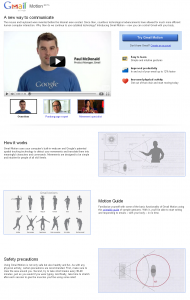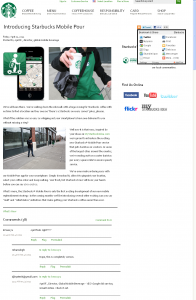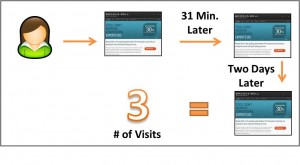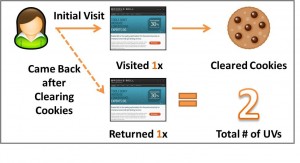A priest, a rabbi, and a minister walk into a bar. And the priest says, “Hey, if we use FourSquare, we’ll save 50% off an appetizer.”
Ugh. It’s pretty hard to mix humor and marketing. It doesn’t mean marketers don’t try every day. Some are wildly successful (Mr. Rolling Cooler Cooler Roller), while others fall flat. Some are even worse…
How to lose customers and alienate people
Gilbert Gottfried was recently fired by Aflac because he brought disgrace to a talking duck. No small task. But the problem was, Gilbert Gottfried was thinking like a comedian, not a marketer. And perhaps Gottfried can be excused, because he’s not really a marketer. He’s been doing standup since he was 15. Job #1 for a comedian is to get the laugh. No matter how inappropriate the joke is, if it’s funny, it’s a success.
Not so for marketers. Job #1 is to sell the product. If you can make a funny ad that sells the product, that’s great. If you can make a boring ad that sells the product, that’s great too. But, never, ever produce anything that alienates your customers. Perhaps the hardest day to successfully walk this tightrope is on April Fool’s Day.
I had loads of fun viewing, dissecting and joking about all of the April Fool’s Day promotions, and I’m sure many of you did as well. But, after a few days, I tried to put on a sober face and a marketer’s hat and analyze these hoaxes – which are essentially marketing promotions – for their possible affect on their target audience. Here’s my Monday morning quarterback analysis of one classic, two recent high performers, and one I think is in serious need of improvement…
Taco Liberty Bell

Click to enlarge
The year was 1996. Back then, the national debt was a pressing problem (you may have to strain a little to imagine a time like that).
The Punchline: Taco Bell is buying the Liberty Bell to pitch in and help with the debt. Thanks to this purchase, it will also be rename this national icon “Taco Liberty Bell” and display it in Taco Bell’s corporate headquarters (Historic sidenote: Since the Internet wasn’t as widely adopted back then, Taco Bell used something our forefathers called a “print ad” to communicate this hoax).
Get it? Because… Taco Bell is at the forefront of groundbreaking marketing campaigns, and marketers will put their names on anything to turn a quick buck.
Analysis: I included this classic example so we could compare this year’s efforts to what marketers were doing before all April Fool’s hoaxes were essentially carried out online. See, it was still possible.
Also, because this was one of my all-time favorites. Probably because “Taco Liberty Bell” is just such a great line, and as a writer I’m a real sucker for great lines. (Writer’s sidenote: Supposedly, the sole reason Jerry Seinfeld made “Bee Movie” was because he loved the punny title).
But, upon thinking about this more, was it really effective? According to Wikipedia, “The campaign cost just $300,000, but it generated an estimated $25 million equivalent in free publicity, with a sales increase exceeding $1 million for the first two days in April.”
It even became a bit of a meme in its day, with then-White House Press Secretary Mike McCurry saying that the government was also “selling the Lincoln Memorial to Ford Motor Company and renaming it the Lincoln-Mercury Memorial.” (Historic sidenote: Ya see, there used to be a Ford brand named Mercury…)
David Paine, Founder of PainePR, the public relations agency that executed the campaign, feels that the climate today is much more cautious and a comparable prank is not possible. Also, it’s harder to stick out with so many companies pulling April Fool’s Day pranks. It’s just become expected.
So, let’s forget those impressive numbers for a second, and try to decipher the messaging. The underlying joke is that Taco Bell is a great marketer. But, is that really its value proposition? My guess is that Taco Bell’s value prop is more along the lines of – “cheap, fast food that’s not a burger.” And this marketing hoax doesn’t convey that idea at all.
Of course, I could be wrong. Maybe Taco Bell would prefer customers focus on the marketing than what’s in the food.
Now on to three examples from April Fool’s Day 2011…
Gmail Motion
The Punchline: No longer are you confined to a mouse and keyboard, great inventions at the time. You can now improve productivity and increase physical activity by typing email with your body motions.
Get it? Because… Google is coming out with so many new, free, cool beta products, you never know what they’re going to come out with next.

Click to enlarge
Analysis: To me, this one is the flat out funniest. I love the main video. The deadpan guy dancing around to write his email messages not only cracked me up…but my daughter as well. Plus, I noticed one of our developers had the Motion Guide posted on his wall. If you can get a writer, a developer, and a 2nd grader, that is a pretty wide demo you’re appealing to.
Overall, I think this prank ties very nicely into Google’s main value prop, which I would guess is “But we, somehow some way, keep coming up with funky cool technology like every single day.” And I think supporting the brand and the main value proposition is essential for everything a marketing department produces, even a prank.
If I had to find fault, though, this perhaps draws some attention to the technological prowess of Google’s main competitors – Apple and Microsoft.
After all, developing a product so you no longer have to use “outdated technologies like the keyboard and mouse” could also refer to touch screen technology, where Apple’s iOS and iPad seem to be beating Google’s Android touch screen operating system pretty handily.
Also, what Google is treating as so difficult and science ”fictiony” as to be an outlandish joke is a reality for customers of Microsoft’s Kinect, “a controller-free gaming and entertainment experience,” in a quote that must have been written by a team of lawyers in Redmond. It’s actually a pretty cool-looking response to the Wii from Microsoft’s Xbox gaming system, a sensor device that picks up motion for a whole-body gaming experience.
Of course, Kinect is just for games, right? Well, some hackers at USC gave Microsoft some nice press off of the Gmail Motion prank by combining Kinect with software they’ve developed to make what seemed ludicrous on April Fool’s Day a reality just a few days later.
Starbucks Mobile Pour

Click to enlarge
The Punchline: Can’t wait to walk to the next corner to get to a Starbucks? You can use a new smartphone app to have a barista on a scooter deliver your cup of coffee to you.
Get it? Because… There is no spot on Earth that is more than 12 seconds away from a Starbucks location. We’re almost too convenient.
Analysis: This ties in very nicely with Starbucks brands and reinforces the main value prop of “much cooler than the average cup of coffee and you can find us everywhere.” Plus, the underlying theme without saying it is…really, you’re getting your coffee at McDonald’s? Would their headquarter people even know what a smartphone is? Or a scooter? Or a decent cup of coffee?
If I had to find fault with this…it’s just not very funny. Yeah, the overall concept is amusing. But they didn’t spend much time on the execution. I think Starbucks was a little nervous about going too far out on the limb. This was even posted by “April F.”
And now, on to a bad attempt at humor…
Insects Raised with Compassion
The Punchline: There’s not one main joke, just a fake Whole Foods Market homepage with headlines like “Insects Raised with Compassion,” “Save Money With Refurbished Spices,” turning the lights off in the store for Earth Day, etc.
Get it? Because… I’m stumped. Best I could come up with is – You’re an idiot forpaying so much for our foods and your environmental leanings should be derided as well.

Click to enlarge
Analysis: To me, this one is a huge fail. I’d say Whole Foods’ value prop is nicely stated right under the logo on their website “Selling the highest quality natural & organic products.” This prank totally undercuts the value prop…and the brand.
I may be harsh because it cuts a little close to home. I shop at Whole Foods. I’m dead center in their target demographic. They make nice margins on food because their customers have deep-seated, eco-friendly values and are looking for healthier food than they could find in the supermarket. Also, occasionally, a little something special, more artisan than Kraft Mac & Cheese at a normal grocer.
And yet, Whole Foods undercuts all of this. This April Fool’s Day prank mocks environmentalists by saying it will shut off all the lights in its store on Earth Day, so you better bring a flashlight or buy one of its “torches of 100% reclaimed wood.” This is clearly based on Earth Hour, a very serious attempt by the World Wildlife Fund to prod action on climate change.
“Insects Raised with Compassion” belittles anyone who would buy more expensive meat because it was raised under more humane conditions. Refurbished spices with “favorite flavors that won’t break the bank” makes me think I might as well buy McCormick in a regular grocery store than fork over the extra bucks to Whole Foods. And the joke about artisan cheese lip balms…maybe artisan cheeses are ridiculous? Maybe I should just stick to the Publix deli?
Look, I can take a joke. I’m not seriously offended. But, remember, the point of marketing is to push product, not to get people to laugh. If this was a standup comedian like Gilbert Gottfried, he could rightly say, “It’s funny. Get over yourself.” But Whole Foods’ job isn’t to be funny; it’s to sell expensive food. This marketing hoax does not do that. It undercuts the brand Whole Foods has worked so hard (and spent so much money) to build.
It’s “The Simpsons” job to make fun of Whole Foods customers, not the Whole Foods marketing department.
Of course, it’s easier to burn down a house than build a new one, so what do I think would be a good marketing hoax from Whole Foods? How about joke that they’ve opened a new organic factory farm where they can now mass produce organic products? Show videos of workers assembling artisanal foods on a Detroit factory assembly line? This would underscore Whole Foods brand, not undercut it. They would be saying, “The joke is on the people who buy the mass-produced ‘food’ product and don’t buy our stuff.”
Laugh with your customers, never at them.
Related Resources
Marketing Wisdom: In the end, it’s all about…
Marketing Career: You must be your company’s corporate conscience
Top Online Marketing Lessons of 2010: What worked and what didn’t in the last 365 days of experimentation –Web Clinic Replay
Free MarketingSherpa Newsletters









 The week before last, I attended Dreamforce, along with more than 45,000 marketing and sales professionals, as a guest of
The week before last, I attended Dreamforce, along with more than 45,000 marketing and sales professionals, as a guest of 








